Canada boasts a remarkable array of caves with unique features, geological formations, and hidden wonders waiting for people to explore. From mysterious depths, these subterranean landscapes offer a fascinating journey into the heart of the Earth. Whether you’re an avid spelunker or a curious nature enthusiast, there’s something for every adventurer. These caves, formed within various rock types such as limestone and sandstone, are home to diverse wildlife. Guided tours and the rich historical context of some caves add an extra layer of intrigue to these underground expeditions. Let’s explore 15 common and lesser-known caves in Canada.
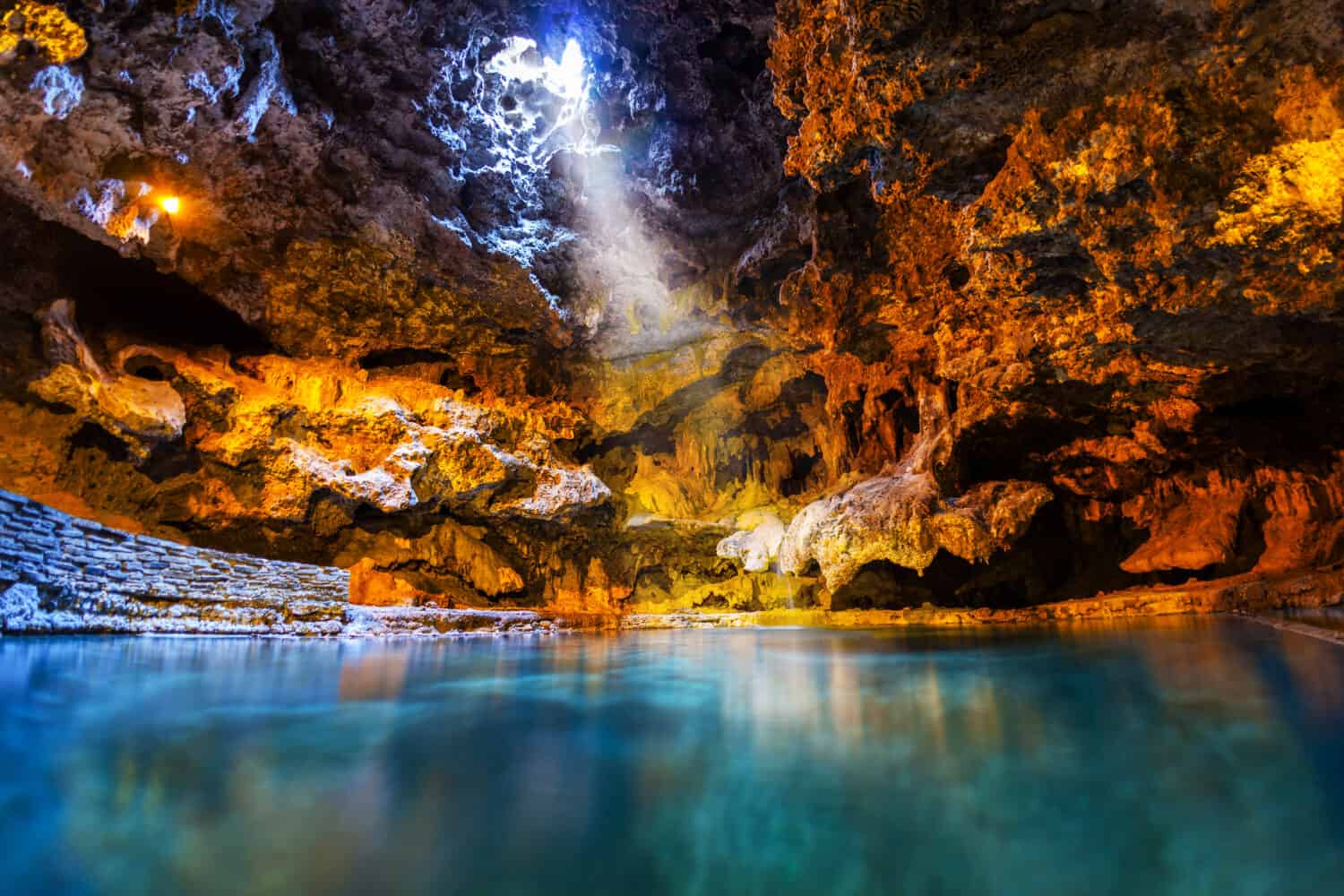
There are a plethora of caves to be explored all across Canada.
©Ronnie Chua/Shutterstock.com
1. Horne Lake Caves (British Columbia)
The Horne Lake Caves are located in Horne Lake Provincial Park on Vancouver Island in British Columbia. These caves are a captivating underground wonder. These limestone caves offer explorers a vast network of passages to discover. With over 1,000 meters of cave systems, there is much to explore, including multiple chambers, tunnels, and intriguing geological formations.
Formed by the slow dissolution of limestone over thousands of years, the Horne Lake Caves feature impressive stalactites, stalagmites, flowstone, and crystalline formations. These geological wonders create a magical ambiance within the caves, dazzling visitors with their natural beauty.
While exploring the caves, one may encounter unique wildlife adapted to the dark and subterranean environment. Bats, such as the little brown bat and the big brown bat, call these caves home. These fascinating creatures navigate through the darkness using echolocation, a natural sonar system that helps them find their way. Cave crickets, with their long antennae and strong jumping ability, can also be found.
Guided tours are the only way for visitors to safely and responsibly explore Horne Lake Caves. Experienced guides lead the way, providing insights into the cave’s geological features, wildlife, and historical significance. These tours offer a unique opportunity to learn about the cave’s formation, the natural wonders within, and the area’s cultural heritage.
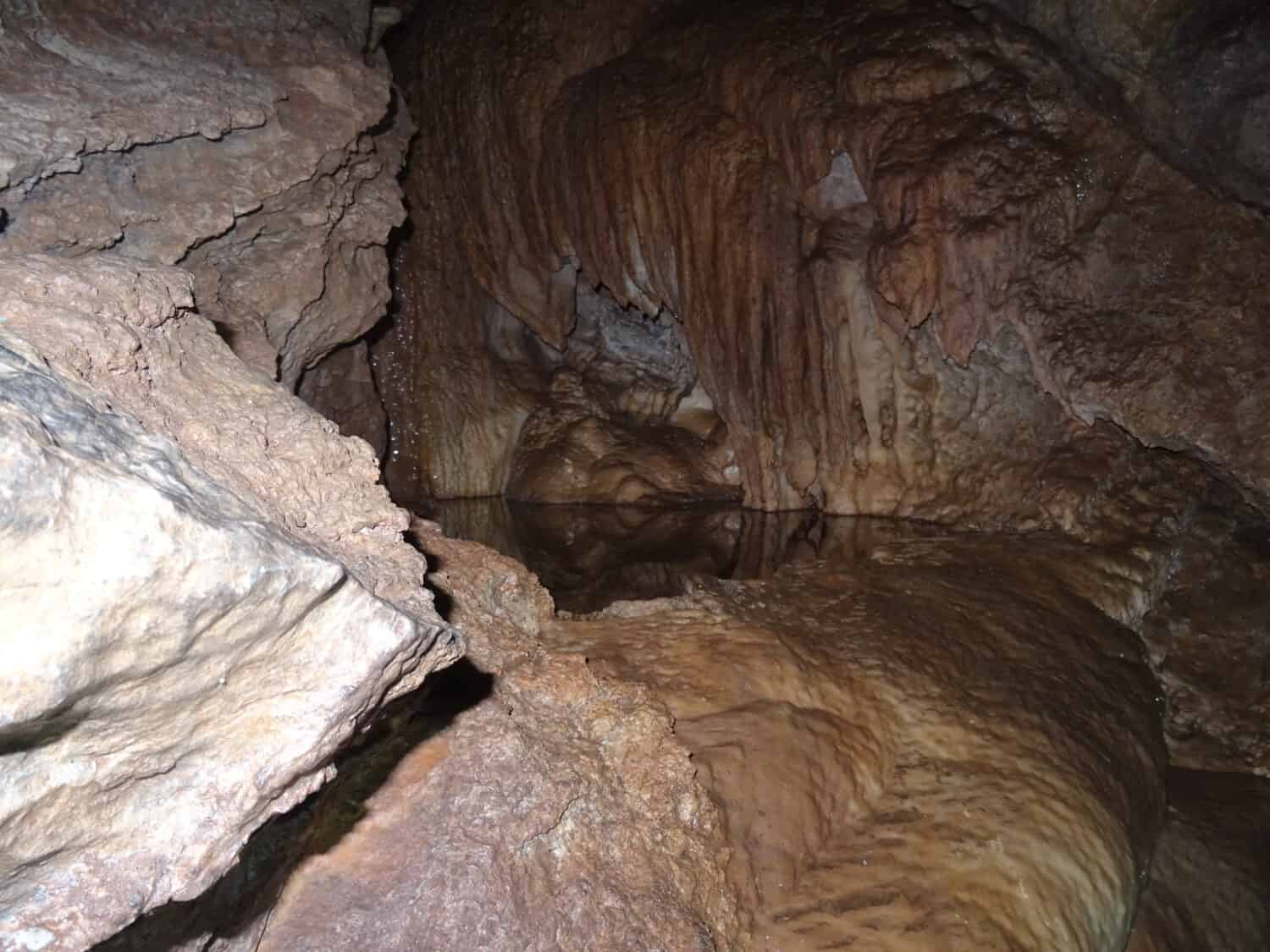
Horne Lake Caves has plentiful options for guided cave exploration.
©Daryck Riddell/Shutterstock.com
2. Grotte Saint Elzéar (Quebec)
Nestled in the magnificent Gaspé Peninsula of Quebec, Grotte Saint Elzéar is a captivating cave system. These limestone caves offer a unique underground experience filled with natural wonders and cultural history. According to the Government of Quebec, it is one of the oldest cave systems in Canada.
Moreover, the Grotte Saint Elzéar cave system comprises a fascinating labyrinth of passages and chambers. Guided tours allow visitors to delve into the heart of the caves, discovering the intricate geological formations that have formed over thousands of years. Stalactites and stalagmites, along with other breathtaking calcite formations, adorn the cave walls, creating a mesmerizing spectacle.
Formed through the gradual dissolution of limestone by water, the Grotte Saint Elzéar caves display the remarkable work of nature’s artistic hand. Over time, the slow drip of water has sculpted these magnificent formations, captivating explorers with their intricate beauty.
The caves harbor a unique ecosystem that has adapted to the subterranean environment. Bats, such as the little brown bat and the northern long-eared bat, inhabit the Grotte Saint Elzéar, using it as a roosting site. These fascinating creatures are essential for maintaining a healthy balance within the cave ecosystem. Other cave-adapted invertebrates, such as cave beetles and spiders, can also be found.
Finally, guided tours of the Grotte Saint Elzéar allow visitors to learn more about the geological wonders and cultural significance of the caves. Knowledgeable guides lead the way, sharing insights into the cave’s formation, the unique features of the rock formations, and the historical use of the caves by Indigenous peoples.

There are various guided tours available to explore the Grotte Saint Elzéar cave system.
©Marina Poushkina/Shutterstock.com
3. Bruce Peninsula Caves (Ontario)
Located in the Bruce Peninsula National Park in Ontario, Canada, the Bruce Peninsula Caves offer a fascinating underground adventure. This area is renowned for its extensive cave systems, boasting a network of passages, tunnels, and chambers. One of the most famous caves in the region is the Bruce Cave, a popular destination for avid explorers and nature enthusiasts.
Moreover, the caves of the Bruce Peninsula are primarily composed of the underlying Niagara Escarpment, a geological formation made of limestone. Over time, the erosive forces of water have carved out these intricate cave systems, leaving behind awe-inspiring rock formations, such as stalactites, stalagmites, and flowstone.
Furthermore, these caves are home to various wildlife species that have adapted to the unique environment. Bats, including the little brown bat and the endangered Indiana bat, are among the most notable inhabitants. These fascinating creatures use the caves as roosting sites, playing a crucial role in maintaining the delicate balance of the cave ecosystem, amongst other common cave-dwelling organisms.
Guided tours are available for visitors to explore the Bruce Peninsula Caves safely. Experienced guides provide valuable insights into the caves’ geological wonders and ecological significance. They also share interesting facts about the history of the caves and the local area, enriching the overall experience.
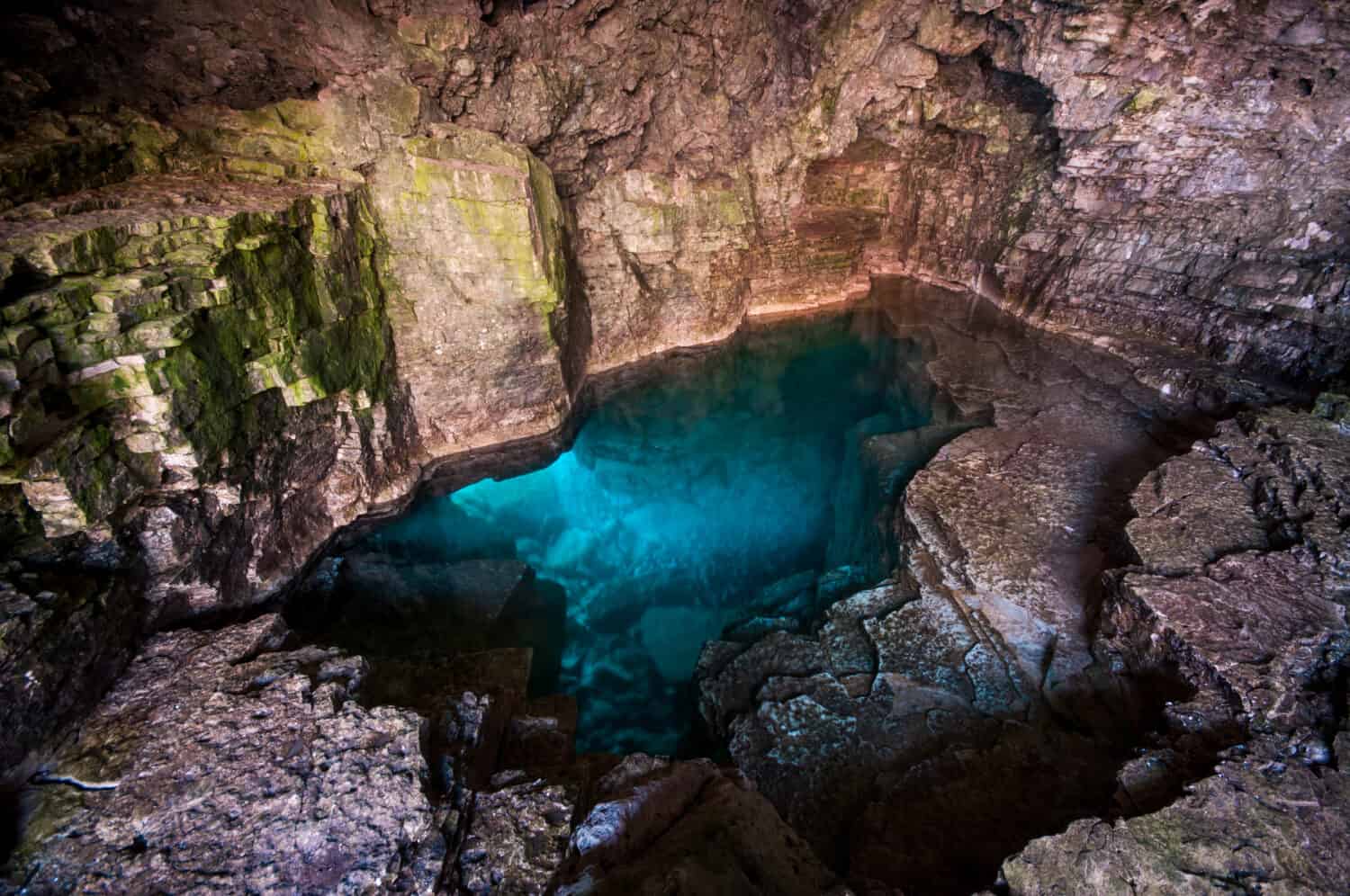
The Grotto is a popular cave within the Bruce Peninsula Caves.
©Georgian Bay Boudoir/Shutterstock.com
4. Bonnechere Caves (Ontario)
Nestled in Eganville, Ontario, the Bonnechere Caves are a hidden gem amongst the many caves in Canada. These captivating caves give visitors a unique underground experience, boasting an intricate network of passages, tunnels, and chambers to explore.
Moreover, the Bonnechere Caves formed within limestone. Visitors who venture through the caves will be awestruck by the remarkable geological formations, including stalactites, stalagmites, and fossilized marine life embedded within the rock walls.
The caves are also home to various wildlife species that have adapted to the subterranean environment. Fascinating creatures inhabit this cave, including a variety of bats, cave crickets, and cave beetles, to name a few.
Furthermore, guided tours are available at the Bonnechere Caves, providing visitors with an opportunity to learn about the caves’ geology, history, and unique features. Knowledgeable guides lead the way, sharing insights into the caves’ formation, the fossilized remains’ significance, and the area’s cultural heritage.
Finally, what sets the Bonnechere Caves apart is its fascinating underground river. As visitors make their way through the caves, they can witness the subterranean river flowing beneath their feet, adding an element of wonder and intrigue to the experience. The river has played a significant role in forming the caves, carving out the passages, and shaping the unique geological features.

Bonnechere Caves has an underground river.
©Alisa_Ch/Shutterstock.com
5. Rat’s Nest Cave (Alberta)
Rat’s Nest Cave, located near Canmore, Alberta, offers an extraordinary underground adventure. This cave system presents a fascinating labyrinth of passages, tunnels, and chambers.
Moreover, the Rat’s Nest Cave is part of a more extensive network of caves in the area. With over four kilometers of passages to navigate, adventurers have ample opportunities to delve deep into the subterranean world. It is one of the longest cave systems in Canada. The cave system features intricate geological formations, including stalactites, stalagmites, and calcite formations, which create a mesmerizing underground landscape.
Primarily formed within limestone, Rat’s Nest Cave provides an opportunity to witness the captivating work of water over time. Within the cave, visitors may encounter a variety of wildlife in the dense cave environment. Bats are the most prominent inhabitants.
Finally, guided tours from Canmore Cave Tours are available for visitors to explore Rat’s Nest Cave safely. Knowledgeable guides provide insights into the cave’s geological features, wildlife, and historical significance. Participants are equipped with helmets, headlamps, and other necessary gear to ensure a safe and enjoyable experience.

Canmore Cave Tours is a popular guide company leading tours within Rat’s Nest Cave.
©CreatingEzra/Shutterstock.com
6. Lusk Cave (Quebec)
Lusk Cave, a cave in Canada located in Gatineau Park, Quebec, offers a unique and thrilling caving experience. The cave system consists of a series of passages and chambers, offering a range of exploration opportunities. Adventurers can navigate through narrow passages, climb over rocks, and marvel at intriguing geological formations. Lusk Cave showcases stunning features such as stalactites, stalagmites, and flowstone, which create a captivating visual spectacle.
Moreover, the caves of Gatineau Park consist primarily of limestone. Over time, the water’s gradual dissolution of the rock has shaped the intricate cave formations that exist today. Explorers can witness water’s remarkable power and its effects on the landscape.
Lusk Cave is home to various wildlife species that have adapted to the cave environment. Bats, including the little brown bat and the northern long-eared bat, use the caves as roosting sites. Other cave-adapted organisms that visitors can encounter here include cave crickets and cave beetles.
Furthermore, guided tours are available for visitors to Lusk Cave. They ensure a safe and informative experience for visitors. Experienced guides provide insights into the cave’s geology, history, and the unique flora and fauna that call it home. They advise visitors to wear appropriate footwear and bring headlamps for a comfortable and enjoyable exploration.
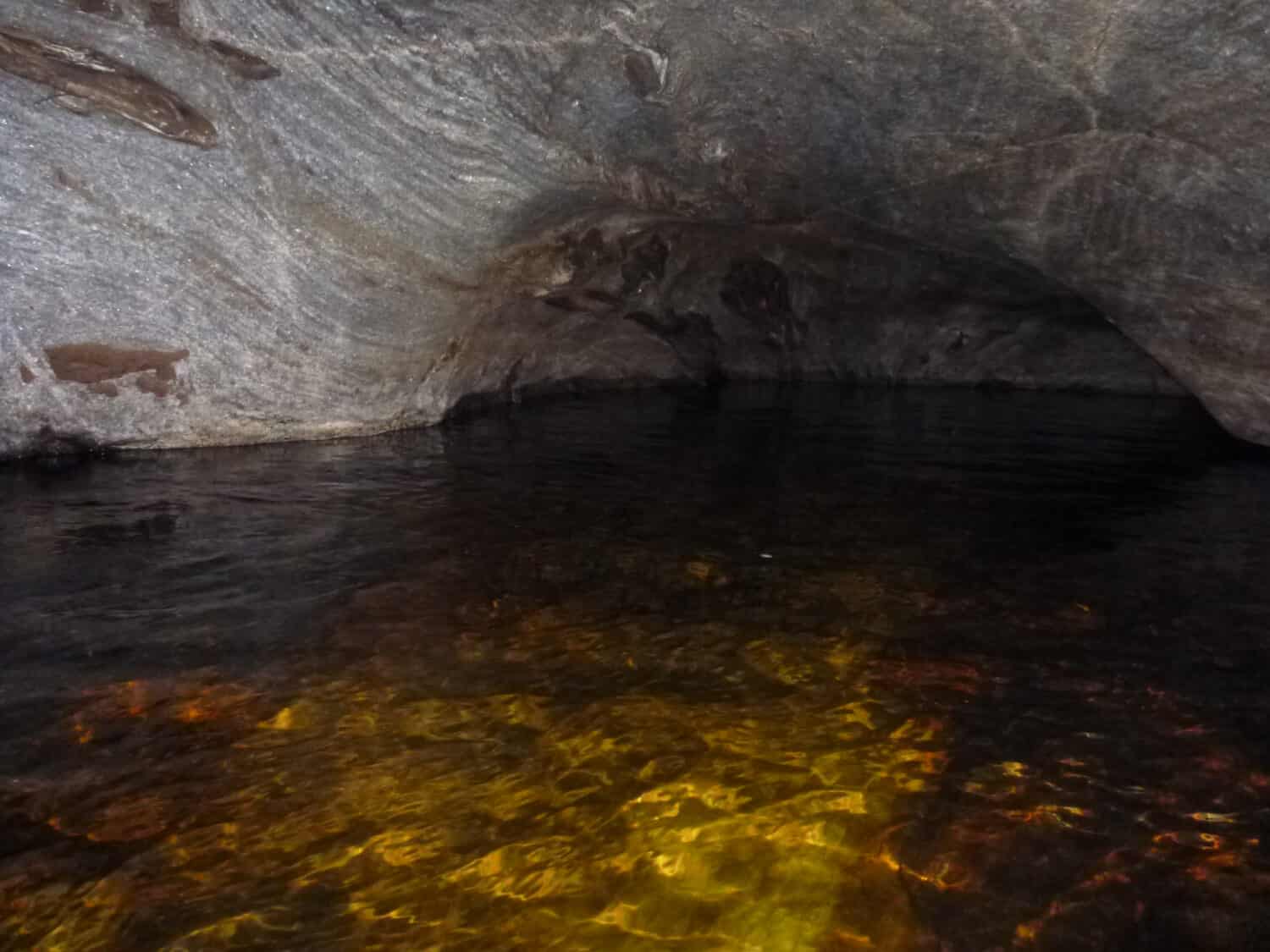
Lusk Cave consists primarily of limestone.
©Cedric_B/Shutterstock.com
7. Marble Canyon (British Columbia)
Marble Canyon, situated in Kootenay National Park, British Columbia, is a breathtaking natural wonder. Although not a traditional cave, it features a unique geological formation worth exploring.
Additionally, the canyon got its name for its striking limestone walls, resembling marble’s smooth texture. Erosion by water has created a narrow, winding gorge, revealing sedimentary rock layers forming the canyon walls. While not a traditional cave system, Marble Canyon offers visitors a chance to witness the incredible forces of nature at work.
Finally, within and around Marble Canyon, visitors can witness various wildlife. The park is home to many bird species, including eagles and falcons, which soar above the canyon’s cliffs. Small mammals such as squirrels and marmots scurry along the forested areas surrounding the canyon. Lucky visitors may even glimpse larger mammals like black bears or elk.

Marble Canyon, within Kootenay National Park, has cave-like formations.
©Konstantin Shabalin/Shutterstock.com
8. Wells Gray Park Cave (British Columbia)
Wells Gray Park Cave, also known as Sarlacc’s Pit, resides in Wells Gray Provincial Park in British Columbia. The exact extent of the cave system in Canada is still unknown. People are still discovering the extent of its depths, but current estimates suggest it is roughly 135 meters long. However, the cave may contain multiple passages and chambers that remain unexplored. As visitors navigate through the cave, primarily composed of limestone, they will encounter intriguing geological formations, such as stalactites, stalagmites, and underground water features, which add an air of mystery to the cave’s ambiance.
The surrounding area of Wells Gray Park Cave is home to a variety of wildlife. Diverse bird species, such as eagles and owls, inhabit forested regions around the cave. It is common to spot them nesting among the trees. It is also common to encounter small mammals like squirrels, rabbits, and occasionally deer in the nearby woods.
There are no guided tours for this cave. It remains mostly inaccessible, covered in snow for the majority of the year. However, there is a small yet risky window for exploration each fall season when the snow has receded enough.
What makes this cave truly special is its unique underground environment and the sense of discovery that comes with exploring its depths.

Within British Columbia, a newly discovered cave named Wells Gray Park Cave, also known as Sarlacc’s Pit, exists. It remains largely undiscovered and difficult to access due to snow cover over the entrance for the majority of the year.
©EB Adventure Photography/Shutterstock.com
9. Corner Brook Caves (Newfoundland and Labrador)
Visitors can find the Corner Brook Caves in Marble Mountain across Newfoundland and Labrador. This remarkable cave consists of a single cave system with an intricate network of passages, tunnels, and chambers. Visitors navigating the cave will encounter stunning geological formations, including stalactites, stalagmites, and complex calcite formations. The narrowing passages and tight squeezes give the cave its name and add an element of excitement to the exploration.
Corner Brook Caves consists mainly of limestone and provides a home to various wildlife species that have adapted to the cave environment. Different creatures aid in maintaining the delicate balance of the cave ecosystem. Some include the northern long-eared bat, cave spiders, and camel crickets.
Guided tours are available. Respecting the cave’s fragile ecosystem and following safety protocols to ensure a memorable and responsible experience is essential.
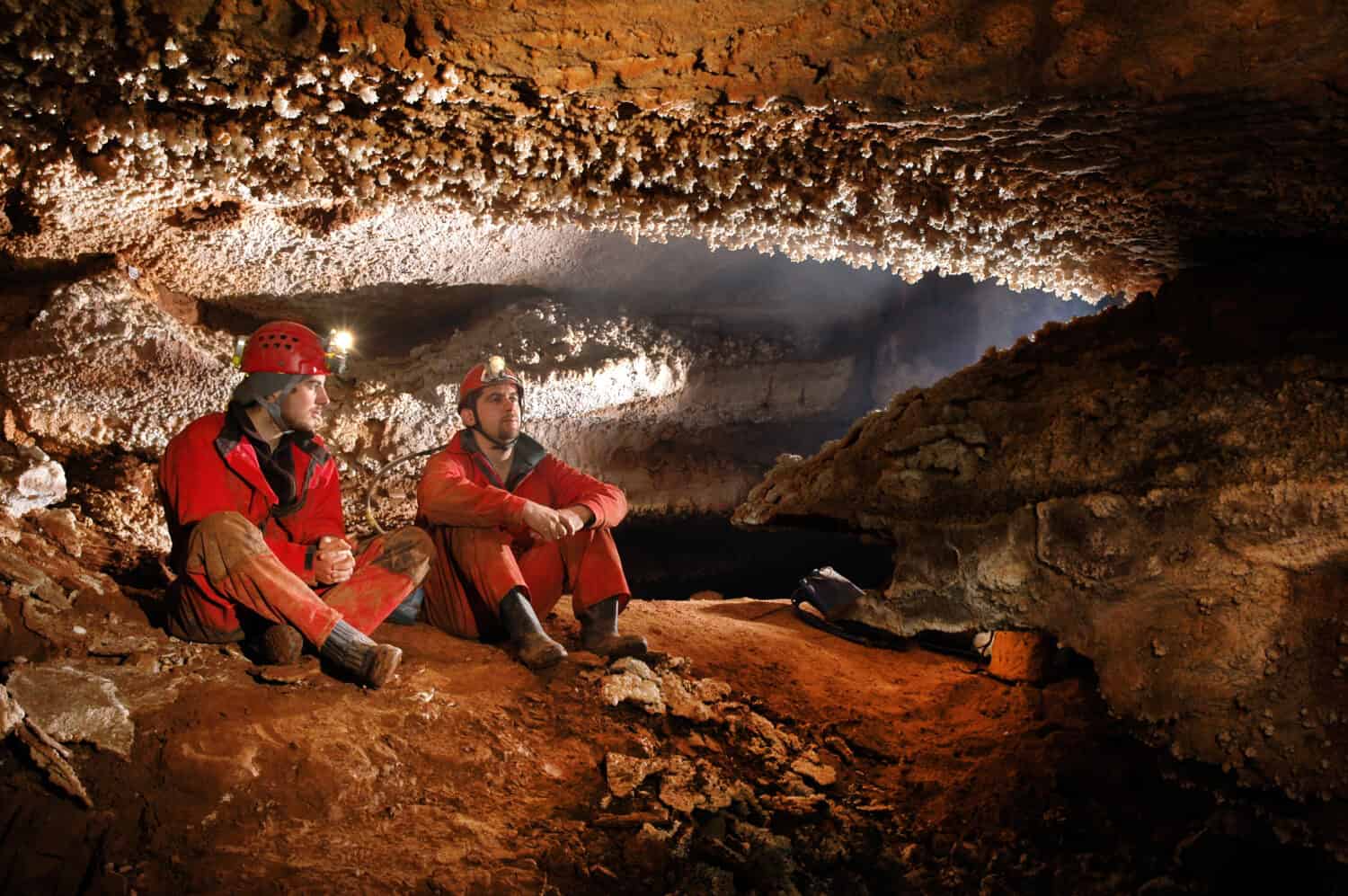
The definition of spelunking is to explore caves.
©salajean/Shutterstock.com
10. Caves at Thunder Cove Beach (Prince Edward Island)
Visitors will find cave formations at Thunder Cove Beach on Prince Edward Island. This enchanting beach offers various cave formations amidst the island’s coastal beauty.
Visitors to Thunder Cove Beach will find themselves captivated by the impressive sandstone formations, with numerous small caves dotting the shoreline alongside dunes, cliffs, and sea stacks.
The caves mainly comprise sandstone through the gradual deposition of sand and sediment. The erosive forces of water have shaped the cave’s features, creating an underground landscape of beauty and intrigue.
Wildlife in and around Thunder Cove Beach is diverse and fascinating. The coastal environment surrounding the beach is home to various bird species, including shorebirds, gulls, and terns. Explorers may also encounter marine creatures such as crabs and fish. Visitors should always take care to respect and protect the fragile coastal ecosystem.
Guided tours are available, giving visitors insights into the geological features and cultural significance of the area, but they do not focus on the cave formation. Exploring on your own is also an option, but use caution around the sandstone cliffs and caves are fragile.
What makes the cave formations at Thunder Cove Beach truly special is its harmonious resonance and the serene coastal setting that envelops it. The combination of the cave’s melodic quality, the breathtaking coastal views, and the area’s rich biodiversity create a truly memorable experience for those who venture into its depths.
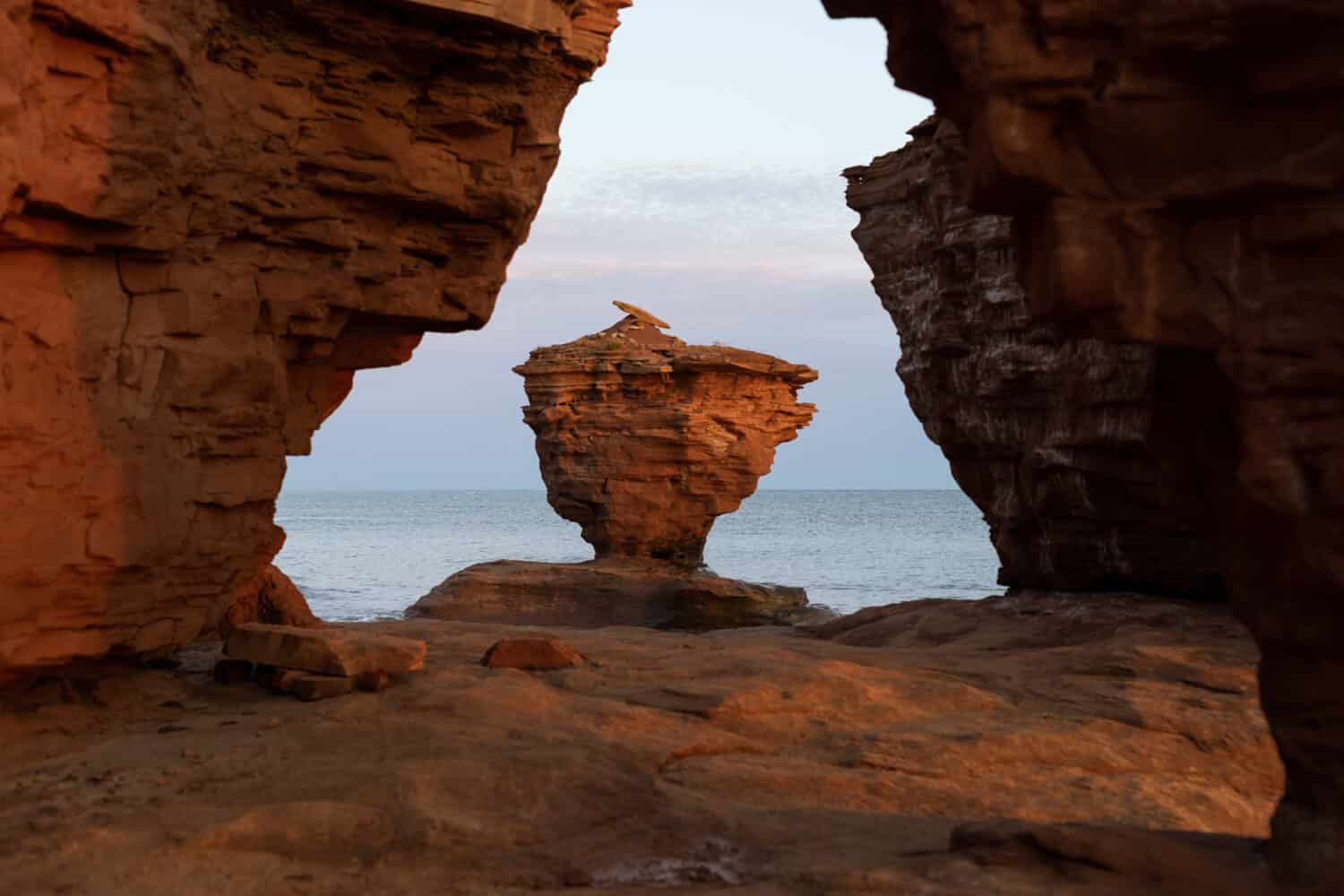
Along Thunder Cove Beach, you can find cave formations, sea stacks, dunes, and cliffs composed of sandstone.
©Curtis Watson/Shutterstock.com
11. Bruce’s Caves (Ontario)
Last on our list of caves in Canada is Bruce’s Caves reside in the Georgian Bluffs in Ontario. These captivating cave formations provide an opportunity to explore aboveground caves amidst the region’s picturesque landscapes.
Bruce’s Caves, while not extensive, offers visitors a chance to venture and witness a hidden geological wonder. There are no guided tours, and it is easily accessible by hiking the Bruce’s Caves Conservation Area Trail.
The surrounding area of Bruce’s Caves is home to various wildlife. There are plentiful birdwatching opportunities, with numerous species inhabiting the area. Visitors may spot migratory birds, waterfowl, and raptors as they explore the county’s natural beauty.

Bruce’s Caves consists of various above-ground rock formations that have resulted in cave-like structures.
©mshirani/Shutterstock.com
The photo featured at the top of this post is © CreatingEzra/Shutterstock.com
Thank you for reading! Have some feedback for us? Contact the AZ Animals editorial team.






